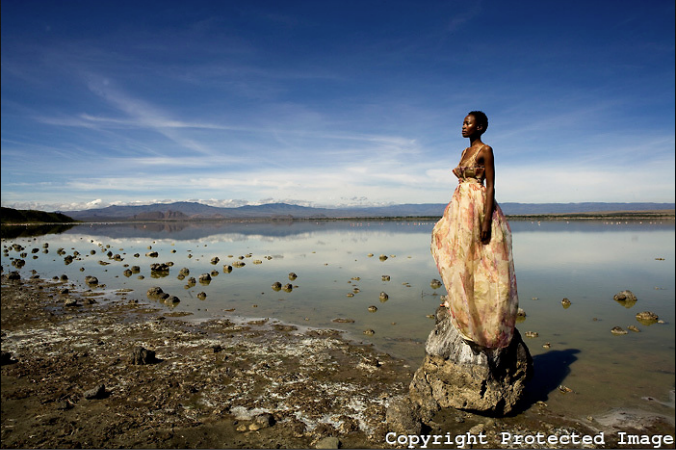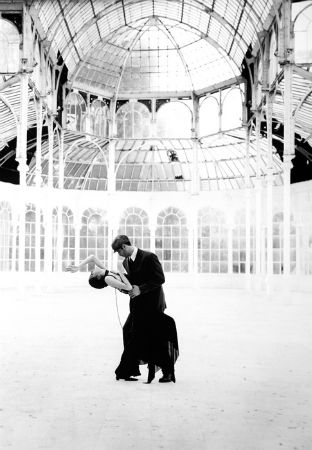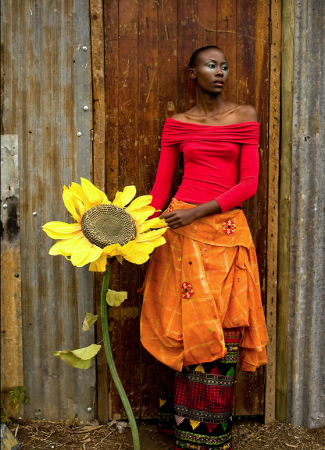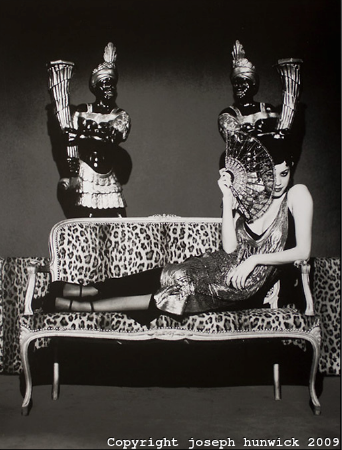 Introduction and interview by Megan Angell –
Joseph Hunwick’s excitement for “seeing the beauty in a situation” and photographing it is what has led him to an impressive career in fashion photography. Throughout his extensive career in the industry he has photographed for the likes of GQ, Marie Claire, Monsoon, and The New York Times. His work has graced the covers and pages of some of the biggest publications in the world and with his remarkable portfolio of work stretching over twenty-five years of working in photography; it’s exciting to know that he is now based in Glastonbury’s own Red Brick Building, where I met him to do an interview for The Basis and The Fix.
Introduction and interview by Megan Angell –
Joseph Hunwick’s excitement for “seeing the beauty in a situation” and photographing it is what has led him to an impressive career in fashion photography. Throughout his extensive career in the industry he has photographed for the likes of GQ, Marie Claire, Monsoon, and The New York Times. His work has graced the covers and pages of some of the biggest publications in the world and with his remarkable portfolio of work stretching over twenty-five years of working in photography; it’s exciting to know that he is now based in Glastonbury’s own Red Brick Building, where I met him to do an interview for The Basis and The Fix.
 So you like working with a big team?
I can work with either a big team or not, but I really enjoy working with a team because firstly, it gets the energy going. Secondly, you’re working with people who know what they’re doing and are talented, so you really don’t have to worry about anything. My specific purpose is to be there when the model is placed in front of me and get the best out of them; the light, shape, form, to look at the colours and to feel the beauty in the situation.
As well as fashion, your portfolio also includes a lot of travel photography with images taken from all around the world. Where would you say is the most inspiring place that you’ve photographed?
I’d probably say Cairo and Timbuktu. On the surface, Timbuktu looks like a very dusty town, but it’s a town just north of the most northerly point of the River Niger, so it was a really important trading town. Cairo is an incredible place, but it’s probably changed quite a lot since I’ve been. I love Cuba as well.
If you could pick any place in any time where and which period would you like to photograph and why?
One example would be to go back to the mining on the Mendips 2000 years ago. That would be interesting. I’d probably like to see Africa before we’d made contact.
What are you preferred means of shooting? Do you prefer film or digital or studio?
Nowadays I use digital, but I think there will be an upsurge again and a return to film because it’s considered to be a fine art medium now. I always prefer shooting in daylight and that’s why we have this specific studio for the northern light. I would love to be shooting in film again, but the ease of digital is quite amazing. Having said that, I find being in front of a computer to be very tiring and everything is translated onto a two dimensional plain, so there’s not the tactile feel of taking a film, developing it, taking it to the enlarger and then exposing your piece of paper, putting it into the developer and so on. That’s a sensual experience.
Now you find yourself doing a shoot and you’re looking at and even editing pictures between shots. Everything is really sped up, being readied to put on the web and ready to send it out. It’s different now. Much faster moving. I think there’s room for both, though. The magic of using film and printing it; you have material that’s been exposed to light you get a latent image, which you then develop in the chemicals and the image comes out. That’s because of the reaction of the light, chemical and materials, so that’s quite magical.
Your portfolio contains images shot both in black and white and colour. How do you choose between shooting in black and white or colour and what are the benefits of both?
I used colour in my Timbuktu shots because we were dealing with a lot of manuscripts and I wanted to see the textures and how they felt. In Cairo, I did shoot colour as well, but a lot were shot on the RB-67, and I used that because it gave it a dramatic feel and I think black and white describes the world in a very different way to colour. You can say a lot with black and white that you can’t say with colour and obviously vice versa. Black and white is a very expressive medium and for me a good black and white photo is unbeatable.
So you like working with a big team?
I can work with either a big team or not, but I really enjoy working with a team because firstly, it gets the energy going. Secondly, you’re working with people who know what they’re doing and are talented, so you really don’t have to worry about anything. My specific purpose is to be there when the model is placed in front of me and get the best out of them; the light, shape, form, to look at the colours and to feel the beauty in the situation.
As well as fashion, your portfolio also includes a lot of travel photography with images taken from all around the world. Where would you say is the most inspiring place that you’ve photographed?
I’d probably say Cairo and Timbuktu. On the surface, Timbuktu looks like a very dusty town, but it’s a town just north of the most northerly point of the River Niger, so it was a really important trading town. Cairo is an incredible place, but it’s probably changed quite a lot since I’ve been. I love Cuba as well.
If you could pick any place in any time where and which period would you like to photograph and why?
One example would be to go back to the mining on the Mendips 2000 years ago. That would be interesting. I’d probably like to see Africa before we’d made contact.
What are you preferred means of shooting? Do you prefer film or digital or studio?
Nowadays I use digital, but I think there will be an upsurge again and a return to film because it’s considered to be a fine art medium now. I always prefer shooting in daylight and that’s why we have this specific studio for the northern light. I would love to be shooting in film again, but the ease of digital is quite amazing. Having said that, I find being in front of a computer to be very tiring and everything is translated onto a two dimensional plain, so there’s not the tactile feel of taking a film, developing it, taking it to the enlarger and then exposing your piece of paper, putting it into the developer and so on. That’s a sensual experience.
Now you find yourself doing a shoot and you’re looking at and even editing pictures between shots. Everything is really sped up, being readied to put on the web and ready to send it out. It’s different now. Much faster moving. I think there’s room for both, though. The magic of using film and printing it; you have material that’s been exposed to light you get a latent image, which you then develop in the chemicals and the image comes out. That’s because of the reaction of the light, chemical and materials, so that’s quite magical.
Your portfolio contains images shot both in black and white and colour. How do you choose between shooting in black and white or colour and what are the benefits of both?
I used colour in my Timbuktu shots because we were dealing with a lot of manuscripts and I wanted to see the textures and how they felt. In Cairo, I did shoot colour as well, but a lot were shot on the RB-67, and I used that because it gave it a dramatic feel and I think black and white describes the world in a very different way to colour. You can say a lot with black and white that you can’t say with colour and obviously vice versa. Black and white is a very expressive medium and for me a good black and white photo is unbeatable.
 What do you consider to be the three most important elements of creating an exciting photograph?
Being in the moment. It’s a bit like a meditation; the vision comes to you and you take the picture, and the amazing thing is that in that moment you don’t actually see the picture because the shutter’s gone up. So you’re blind to it and the camera isn’t, so you’ve found that moment with in that time space.
Other than that – light, light, light. Light is everything in photography. It means painting with light. Understanding light and being able to use that to mould and to reflect. Light is the most important thing.
You need to be comfortable with the camera and people. With people, it’s having a rapport with them without invading their space so you can allow them to express themselves as they are.
What is the most challenging photograph you’ve tried to execute?
I’m scared of heights and having to go up on a really high crane to photograph something wasn’t very nice. Specifically in fashion there are many challenges. In some shoots we’ve had to build sets and even waterfalls; we did one for Monsoon where we had to build a waterfall that had three prongs of water coming down and all in a studio. It took four days to get one shot with a model in the water holding a bottle. Sometimes with bigger projects it’s challenging because there’s so many elements and people involved. With smaller projects it’s often a case of trying to conjure something out of nothing.
What would be your main piece of advice to aspiring photographers?
Never give up and shoot a lot. Learn about your camera really well. Know about it technically and then forget about it. Know how to shoot manually, study the light, but keep shooting.
Specifically for fashion – put together a team. Get a stylist, find a local designer who makes really beautiful clothes, find somebody who’s really good at hair and make-up, someone who can paint backgrounds, and then get out there and do a shoot. Find a model, don’t go to agencies at first, but maybe after you’ve done a few go to agencies and ask if you can do test shots for their new faces. Just build up the portfolio, and maybe go and shoot with a fashion photographer.
Find photographers that really inspire you and absorb their work; the way they’ve set their shots up, the way they’ve used lighting, how they’ve used colour form and shape. When that excites you, absorb that and bring it into your own style.
Further forward, if you’re approaching a company as a freelance photographer, you need to do your research. It’s not good going to a really funky magazine and offering them a commercial shoot. Make sure you know the different areas within fashion photography. Look at historical costume, hair and make-up. If you look back through history a lot of trends often come back around.
Finally, anyone doing photography now should also be doing video. Learn video, editing on DLSRs, and learn how to shoot, because every shoot now, the clients will want to have a video with it.
What do you consider to be the three most important elements of creating an exciting photograph?
Being in the moment. It’s a bit like a meditation; the vision comes to you and you take the picture, and the amazing thing is that in that moment you don’t actually see the picture because the shutter’s gone up. So you’re blind to it and the camera isn’t, so you’ve found that moment with in that time space.
Other than that – light, light, light. Light is everything in photography. It means painting with light. Understanding light and being able to use that to mould and to reflect. Light is the most important thing.
You need to be comfortable with the camera and people. With people, it’s having a rapport with them without invading their space so you can allow them to express themselves as they are.
What is the most challenging photograph you’ve tried to execute?
I’m scared of heights and having to go up on a really high crane to photograph something wasn’t very nice. Specifically in fashion there are many challenges. In some shoots we’ve had to build sets and even waterfalls; we did one for Monsoon where we had to build a waterfall that had three prongs of water coming down and all in a studio. It took four days to get one shot with a model in the water holding a bottle. Sometimes with bigger projects it’s challenging because there’s so many elements and people involved. With smaller projects it’s often a case of trying to conjure something out of nothing.
What would be your main piece of advice to aspiring photographers?
Never give up and shoot a lot. Learn about your camera really well. Know about it technically and then forget about it. Know how to shoot manually, study the light, but keep shooting.
Specifically for fashion – put together a team. Get a stylist, find a local designer who makes really beautiful clothes, find somebody who’s really good at hair and make-up, someone who can paint backgrounds, and then get out there and do a shoot. Find a model, don’t go to agencies at first, but maybe after you’ve done a few go to agencies and ask if you can do test shots for their new faces. Just build up the portfolio, and maybe go and shoot with a fashion photographer.
Find photographers that really inspire you and absorb their work; the way they’ve set their shots up, the way they’ve used lighting, how they’ve used colour form and shape. When that excites you, absorb that and bring it into your own style.
Further forward, if you’re approaching a company as a freelance photographer, you need to do your research. It’s not good going to a really funky magazine and offering them a commercial shoot. Make sure you know the different areas within fashion photography. Look at historical costume, hair and make-up. If you look back through history a lot of trends often come back around.
Finally, anyone doing photography now should also be doing video. Learn video, editing on DLSRs, and learn how to shoot, because every shoot now, the clients will want to have a video with it.
 To conclude, what’s coming up for you in the next six months?
I’m putting a lot of my energy into the Glastonbury Red Brick Building film and photography. We’re looking at running workshops, providing education and continuing to work in fashion. This is a really important project for the area and we really encourage people to come and join us and participate. We’re looking at building connections with students and sharing knowledge. Also in our studio is local filmmaker, Tim Knock, Phil Shepherd from The Engine Room and Gareth Mills from Speaking Tree. So there’s film, photography and publishing.
I’m also specialising in portraits and I do them for people. It’s really nice doing portraits because people give something of themselves to the camera.
If you would like to find out more about Joseph, view more of his work and find out where he is running local photography workshops, visit: www.jhunwick.com. Alternatively, you can pop in and see him at The Red Brick Building in Glastonbury (www.redbrickglastonbury.co.uk)
To book a photographic session with Joseph, buy prints and for all other enquiries email joseph@jhunwick.com or call 07595 749538 for details.
To conclude, what’s coming up for you in the next six months?
I’m putting a lot of my energy into the Glastonbury Red Brick Building film and photography. We’re looking at running workshops, providing education and continuing to work in fashion. This is a really important project for the area and we really encourage people to come and join us and participate. We’re looking at building connections with students and sharing knowledge. Also in our studio is local filmmaker, Tim Knock, Phil Shepherd from The Engine Room and Gareth Mills from Speaking Tree. So there’s film, photography and publishing.
I’m also specialising in portraits and I do them for people. It’s really nice doing portraits because people give something of themselves to the camera.
If you would like to find out more about Joseph, view more of his work and find out where he is running local photography workshops, visit: www.jhunwick.com. Alternatively, you can pop in and see him at The Red Brick Building in Glastonbury (www.redbrickglastonbury.co.uk)
To book a photographic session with Joseph, buy prints and for all other enquiries email joseph@jhunwick.com or call 07595 749538 for details.